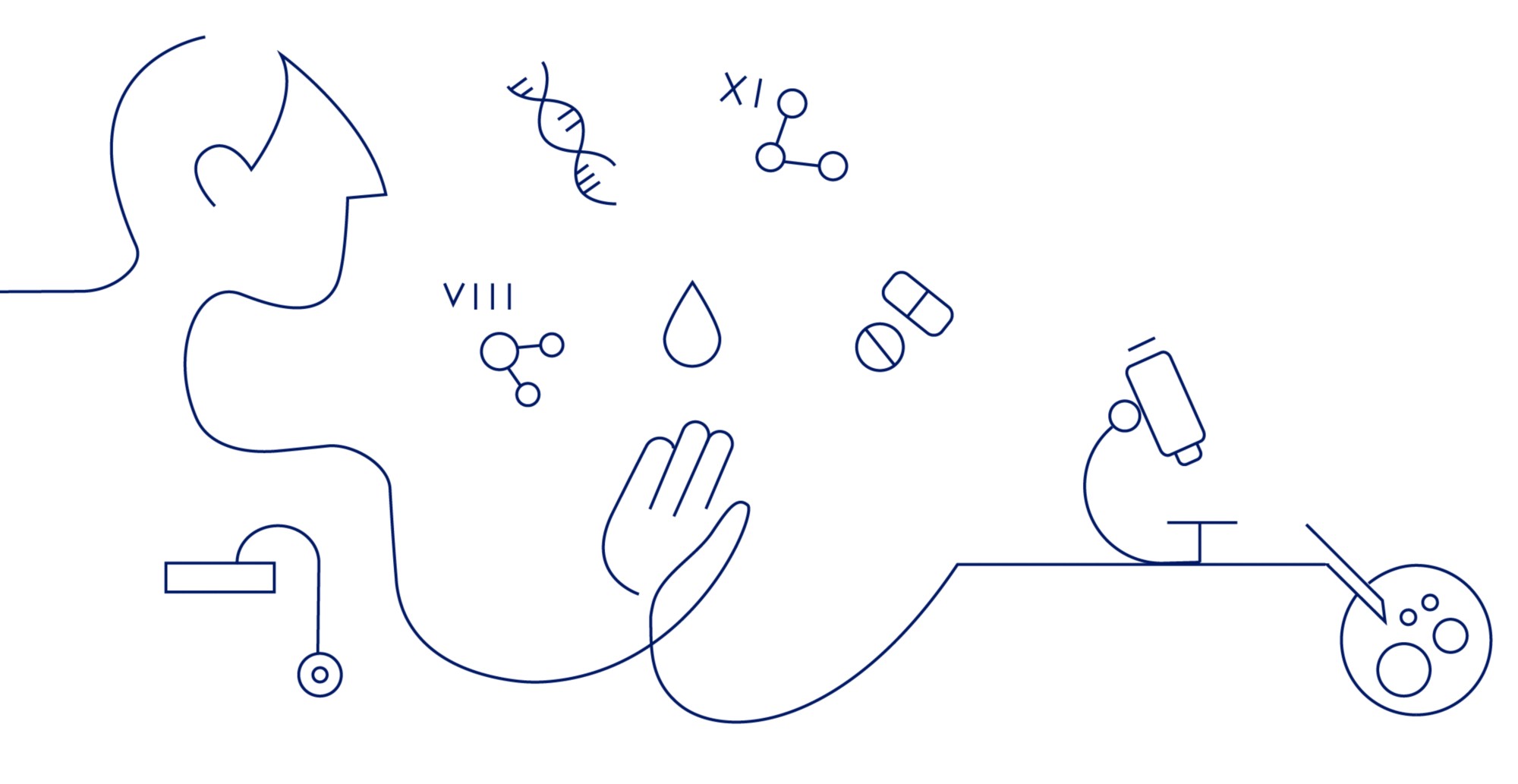Haemophilia is a rare and serious bleeding disorder. It affects the blood's ability to clot. Therefore, people with haemophilia bleed for a longer time than is normal. It is estimated that about 1 in 10,000 people are affected by haemophilia and. 450,000 people are living with haemophilia worldwide.
A person with haemophilia does not have enough coagulation factor in the body. It is typically passed down from parent to child, although about a third of cases are caused by a gene mutation.
There are two different types of haemophilia, A and B.
The most common type is haemophilia A (1 in 5000 male births), where a person does not have enough coagulation factor VIII (FVIII).
Haemophilia B is less common (1 in 25,000-30,000 male births). A person with this type of haemophilia does not have enough coagulation factor IX (FIX). Haemophilia B accounts for only 15–20% of total haemophilia cases.
The genes for both coagulation factors are found on the X chromosome. This is why it mainly affects males, who inherit an affected maternal X chromosome.
It is estimated that 30% of people living with haemophilia A and 1-5% of people living with haemophilia B develop inhibitors. Inhibitors is an immune response to infused factor replacement therapy, making treatment more challenging.
Different varieties of haemophilia are associated with different types of coagulation factors. Replacement therapy supplies the body with the missing factor. Treatments therefore differ depending on which factor is missing. Currently, they can either be administered subcutaneously or by infusion therapy injected into a vein.
Replacement therapy can combat a bleeding episode that's underway. It can also be administered at home on a regular schedule, to help prevent bleeding episodes. Some people living with haemophilia require regular and ongoing replacement therapy.
In the video above, you’ll meet Carl Lyons and learn about his life with severe haemophilia A.
Severe haemophilia usually becomes apparent in the first years of life - often when a child begins to move independently. Haemorrhages often occur in the joints, particularly the weight bearing joints such as knees and ankles.
This pain is often unbearable. Helping young children and adults living with haemophilia to avoid this is what drives our passion and our research.
We combine our experience in protein design with collaborations in the global scientific community. This is how we discover and develop effective and safe medicines for people with haemophilia and other rare bleeding disorders.
In the video above, you’ll meet Ulla Hedner, a leading pioneer in haemophilia treatment. Ulla explains her passion for – and dedication to – helping haemophilia patients.

Our scientists are exploring innovative treatment solutions for haemophilia and rare blood disorders. These solutions are aimed at reducing the current treatment burden and improving clinical outcomes. They are complemented by research into oral treatments and gene therapy.
We strive to offer better quality of life to people living with haemophilia and other rare bleeding disorders.
We often work in partnerships to discover novel targets and innovative compounds and technologies. We work to address the unmet medical needs within rare bleeding disorders. Our focus is on:
- Novel prophylactic agents in haemophilia
- Cell and gene-based therapy approaches
- Clinical assets in rare blood disorders such as sickle-cell disease
Today, our pipeline has exciting potential to ensure we are at the forefront of finding the next generation of innovative medicines for this disease area.
Acquired haemophilia (AH) is different because it’s not inherited. Instead, AH develops later in life in people with no personal or family history of bleeding disorders. AH is extremely rare and occurs when the immune system develops an antibody, or inhibitor, against its own coagulation factor, frequently factor VIII.
With Bernard-Soulier syndrome, a person’s platelets do not stick to an injured blood vessel wall due to a defect in glycoprotein – a protein that helps platelets form a plug and stop bleeding. Bernard-Soulier syndrome is inherited from both parents and can occur in both men and women.
Factor I deficiency means a person has problems with a protein called
fibrinogen, which is needed to help the body form a stable clot.
Factor I deficiency includes afibrinogenemia, hypofibrinogenemia,
dysfibrinogenemia and hypodysfibrinogenemia and occurs in 1 in every 1
million people.
Afibrinogenemia
Afibrinogenemia means a person has no factor 1 (fibrinogen) in their
blood, so their body can’t form a stable clot. It is inherited from
both parents and can occur in both men and women.
Dysfibrinogenemia
Dysfibrinogenemia means that a person has normal levels of factor 1
(fibrinogen), but it doesn’t work as it should. It occurs equally in
men and women and is usually inherited from one parent but can also
develop as a person gets older.
Hypofibrinogenemia
A person with hypofibrinogenemia has lower levels of factor 1 (fibrinogen) in their blood, so their body can’t form a stable clot. It affects both men and women and is usually inherited from both parents but can also develop later in life.
With Factor II deficiency, a person lacks enough Factor II in their blood to form a stable clot. It is one of the rarest inherited bleeding disorders. Studies have shown a higher incidence of Factor II deficiency among the latino population.
People with factor V deficiency have low levels of factor V in the blood so their bodies cannot form a stable clot to stop a bleed. It occurs in 1 in every 1 million people, is inherited from both parents and affects both men and women.
People with factor VII deficiency have low levels of factor VII in their blood. It’s one of the most common rare bleeding disorders, occurring in 1 in 300,000 to 500,000 people. Factor VII deficiency is inherited from both parents and occurs equally in men and women.
Factor VIII deficiency (haemophilia A) means a person has low levels of factor VIII in their blood. It affects mostly males who inherit it from their mothers, but in about 1/3 of people with haemophilia A, there is no family history and it is caused by a gene mutation. Haemophilia A occurs in 1 in 5,000 live male births.
People with factor IX deficiency (haemophilia B) have low levels of factor IX in the blood. Haemophilia B is inherited and affects mostly males. It occurs in 1 in 30,000 live male births.
Factor X deficiency means a person has low levels of factor X in their blood. It occurs in 1 in every 500,000 to 1 million people. It is inherited from both parents but can also develop later in life.
People with factor XI deficiency have low levels of factor XI in their blood. Factor XI deficiency occurs in 1 in 1,000,000 people, is inherited from either parent and occurs in both men and women.
Factor XIII deficiency means a person has low levels of factor XIII in their blood. It occurs in only 1 in every 5 million people. It can occur in both men and women and is usually inherited from both parents but can also develop later in life.
In Glanzmann’s thrombasthenia (GT), glycoprotein – a protein that helps platelets stick together to form a plug and stop bleeding – is defective or not present at all. GT is inherited from both parents and can occur in both men and women.
Platelets require granules to form a plug and stop bleeding. In platelet storage pool deficiency, the granules don’t work properly, and platelets cannot form a plug to stop bleeding. This disorder is usually inherited from one or both parents and occurs in both men and women.
Sickle cell disease (SCD) is a rare genetic disorder characterised by a change in the shape of the red blood cells from a smooth doughnut-shaped cell into a half-moon or ‘sickle’ shape. Approximately 17 million people live with the disease, while approximately 300,000 children are born with it every year.
A person with Von Willebrand disease (VWD) either doesn’t have the normal level of an important protein or the protein doesn’t work as it should—so their body can’t form a stable clot. 1 in every 100 people have some form of the disease. It’s inherited from one or both parents and affects men and women equally.
